Identification of two distinct progenitor populations in the lateral ganglionic eminence: implications for striatal and olfactory bulb neurogenesis
- PMID: 12514213
- PMCID: PMC6742158
- DOI: 10.1523/JNEUROSCI.23-01-00167.2003
Identification of two distinct progenitor populations in the lateral ganglionic eminence: implications for striatal and olfactory bulb neurogenesis
Abstract
The lateral ganglionic eminence (LGE) is known to give rise to striatal projection neurons as well as interneurons, which migrate in the rostral migratory stream (RMS) to populate the granule cell and glomerular layers of the olfactory bulb. Because all of these neuronal subtypes express Distalless-related (DLX) homeobox proteins during their differentiation, we set out to further characterize progenitors in the Dlx-positive domain of the LGE. Previous studies have shown that the LIM homeobox protein Islet1 (ISL1) marks the LGE subventricular zone (SVZ) and differentiating striatal projection neurons. However, ISL1 is not expressed in neurons of the developing olfactory bulb or the RMS. We show here that the dorsal-most portion of the Dlx-expressing region of the LGE SVZ lacks ISL1 cells. This dorsal domain, however, contains cells that express the ETS transcription factor Er81, which is also expressed in granule and periglomerular cells of the developing and adult olfactory bulb. Moreover, the adult SVZ and RMS contain numerous Er81-positive cells. Fate-mapping studies using Dlx5/6-cre transgenic mice demonstrate that Er81-positive cells in the granule cell and glomerular layers of the olfactory bulb derive from the Dlx-expressing SVZ region. These findings suggest that the LGE SVZ contains two distinct progenitor populations: a DLX(+);ISL1(+) population representing striatal progenitors and a DLX(+);Er81(+) population comprising olfactory bulb interneuron progenitors. In support of this, mice mutant for the homeobox genes Gsh2 and Gsh1/2, which show olfactory bulb defects, exhibit dramatically reduced numbers of Er81-positive cells in the LGE SVZ as well as in the olfactory bulb mantle.
Figures
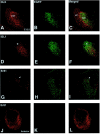
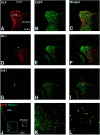
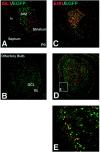

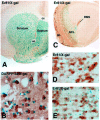
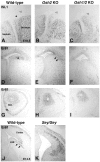
References
-
- Anchan RM, Drake DP, Haines CF, Gerwe EA, LaMantia AS. Disruption of local retinoid-mediated gene expression accompanies abnormal development in the mammalian olfactory pathway. J Comp Neurol. 1997;379:171–184. - PubMed
-
- Anderson KD, Reiner A. Immunohistochemical localization of DARPP-32 in striatal projection neurons and striatal interneurons: implications for the localization of D1-like dopamine receptors on different types of striatal neurons. Brain Res. 1991;568:235–243. - PubMed
-
- Anderson SA, Qiu M, Bulfone A, Eisenstat DD, Meneses J, Pedersen R, Rubenstein JL. Mutations of the homeobox genes Dlx-1 and Dlx-2 disrupt the striatal subventricular zone and differentiation of late born striatal neurons. Neuron. 1997;19:27–37. - PubMed
-
- Anderson SA, Marin O, Horn C, Jennings K, Rubenstein JL. Distinct cortical migrations from the medial and lateral ganglionic eminences. Development. 2001;128:353–363. - PubMed
Publication types
MeSH terms
Substances
LinkOut - more resources
Full Text Sources
Other Literature Sources
Medical
Molecular Biology Databases
Research Materials
